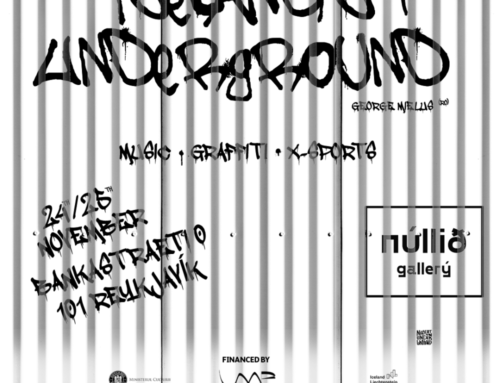Post-graffiti art: CRASH, DAZE
By John Matos, Chris Ellis at the Janis Gallery, New York and Arthur C. Danto.
Full Text is © 1985 The Nation Company Inc.
When Tony Silver and Henry Chalfant set out a few years ago to make a film about what they perceived as the endangered culture of the South Bronx – graffiti, break dancing, disco rapping – their motives were, in a sense, ethnographic. Those forms of expression were endangered, but not quite in the way the filmmakers had supposed. By the time their Style Wars was shown on PBS to wide critical acclaim, the entire Hip-Hop culture had moved horizontally through suburban culture, where it was already beginning to fade, and vertically into the reaches of high culture, where it was appropriated by artists very different from those who had invented it. Break dancing had been incorporated into ballet, rapping doubtless awaited an operatic future and the idioms of graffiti had been internalized by painters who lived far from the violent matrices of ghetto streets. Hip-Hop culture was thereby gentrified from two directions, to the marginal advantage of its originators. Rappers, to be sure, made tapes, at best an ephemeral monument; breakers, thin and tough as rope, instructed members of the leisure classes who saw in their contortions the next thing after yoga and jogging. But the writers, as they called themselves, were scouted by the are world and, for the first time, cash became a factor for young men and women who had heretofore operated for glory and beauty alone. The most dispiriting sequence in Style Wars shows these young knights of the spray can being lionised by crass esthetes.
There can be few developments in the history of art quite so remarkable as that which began with the inscriptions „TAKI 183” which covered New York around 1971 and culminated, almost immediately, in the full-scale subway-car calligram with its elaborate iconography, its brash signatory notations and its witty communications to a population that saw, mostly, disorderly evidence of a municipality held hostage by vandals. Sprouting abruptly as mushrooms, a spontaneous art complex as nuanced and structured as that of Siena in the trecento was in place. It had workshops, masters and apprentices; a system of nicknames or „tags” (most artists of the Renaissance are known to us by their tags: Barbarelli as Giorgione, or Big George; Tommaso Guidi as Masaccio, or Bad Tommy; Jacopo Robusti as Tintoretto, or Little Dyer; and so forth); a critical vocabulary; an esthetic code; a philosophy of art; and the elements of an art history. Since the subway system was at once art school and cathedral wall, a preponderance of awful scribbling accompanied the majestic progress of the masterpieces through dank and scary tunnels. Few who observed the visual cacophony from stops in four boroughs were prepared to make fine distinctions, and even those responsive to the masterpieces – those „bouquets of colors from the Caribbean,” as Claes Oldenburg described them – had some doubts as to whether the costs were worth the occasional splendor. And everyone was aware that laws were being broken so that the writers could, as the expression went, „get up.” There is little doubt that the consciousness of lawbreaking and its attendant risks was an important element in subway art, perhaps contributing to the decision to work monumentally, since the penalty was the same whatever the scale. But it is important to recognize that writing was not a means for breaking the law. In their own eyes the writers were not brutalizing bourgeois sensibility, like Celine, but enhancing public property to the intended gratification of all and the particular fameof him or her who took such risks for art. Artists have legendarily suffered a great deal to get up – but who took greater chances against greater odds than these?
There had always been some speculation as to how the writers’ unquestioned talent might be sundered from the squalor for which they were responsible, and now the social transition has been made, at least by the few who have forsaken the train yard for the uptown gallery and the savageries of the art market. Graffiti continues sullenly in its natural habitat, having been reduced in people’s minds to little more than a sociological problem and an administrative headache. But now we can see whether its transplanted gifts can survive – whether the moral luck through which the ivory portals have swung open to outsiders can be exploited as the beginnings of artistic careers.
This is a very different matter from the elevation of popular forms to high cultural levels. One would, for instance, have expected enfranchised artists to incorporate something of the spirit of graffiti in their works or even, as with Keith Haring, to descend into the tunnels to make a mark on public walls and expose themselves to the same set of sanctions–though to my knowledge Haring has contented himself with stationary surfaces and has not attacked the motile ones of the true subway writer. Super- or hyperrealists might even paint illusionist canvases of flamboyantly embellished subway cars, might even make them life-size. I can imagine a market growing up for salvaged panels from abandoned cars, semiartistic collectibles for authentic lofts. I can even imagine, if Rockefeller were alive, a new wing at the Metropolitan Museum of Art filled with cars purchased from the M.T.A. and generously donated for the instruction and enjoyment of future generations. My concern is with what sort of paintings the original writers can make when enabled by patronage to become studio artists working on surfaces rather more standard than the heavy-duty sneet metal of the I.R.T. The spray can may be a genuine augmentation of the artist’s toolbox, more promising perhaps than the drip-stick of Pollock, since it facilitates the staining of large expanses without any special compromise in expressive vitality. And after all, a number of jazz musicians have ascended the stage at Carnegie Hall with no notable dilution in the quality of music. Why should DAZE and CRASH not make the same transition upward to the Janis Gallery, a little farther east on 57th Street, slightly to the left of the Russian Tea Room?
I have shown some pretty classy „burners” – whole cars done in „wild style” – by CRASH and DAZE. I would place them in the A-minus class of writers – not quite up to SEEN, DONDI, BLADE, SKEME or KASE 2 (a brilliant draftsman) – but of fairly high quality on their own turf. I am struck by the fact that they continue to paint under their noms de metro rather than as John Matos and Chris Ellis, and that their show is advertised by Janis as „graffiti art” – as though they or the gallery had not enough confidence to display their work without benefit of a sociological excuse. But in candor, I think neither of them could survive without benefit of the pedigree and paraphernalia of the culture that formed them, which raises a question of paternalism at least. I was not even tempted to say something like, Not bad for a graffiti writer, since I think well of graffiti when it is good, and as graffiti writers they are good to very good. But working under the imperatives of gallery artists, DAZE and CRASH, For all the vividness of their imagery and the phosphorescence of their coloration, are pretty feeble. And I find it instructive that this should be so, since I think there is an easy answer to the question, Why? It has to do with training rather than talent. Their trouble is knowing too little and knowing how to do too little. They need the benefits of a good art school. Energy alone can only carry you so far.
CRASH is the abler artist, I would judge, and a sign of this is that he remains closer to his original success as a writer. He uses his name as a motif, for example, but works it up into a pictography of things that actually crash, as though within the frame of a comic strip. Inevitably there is a suggestion of Roy Lichtenstein, and it is not surprising that CRASH should use certain mannerisms from Pop Art. Pop must have been the first of contemporary art movements to be publicized in media accessible in the South Bronx; the writer FRED did a car with a row of Campbell soup can in 1980. Since there was very little visible difference between Warhol and a mere advertising illustration, or between Lichtenstein and a panel from a comic book, CRASH and others might have inferred that since Lichtenstein is Art, by authority of the media, and looks just like comic strips, well, comic strips too must be Art. After all, curators in exalted museums make the same inference every day: since Picasso and the primitive look so much alike …
But Lichtenstein was an artist of immense sophistication, steeped in the history of art and in the art world of his time, with a marvelous sense of the semiotics of mechanical sense of the semiotics of mechanical reproduction. What he uses wittily and allusively, CRASH employs without any sense of why it is there to begin with. Think of the use Lichtenstein makes of the dot pattern of the Ben Day screen – a mechanical effect carefully painted in by hand. CRASH picks up on such things because they are there, with no clear sense that in Lichtenstein they carry a significance wholly absent from his own work. CRASH uses huge cropped heads, and there is a clever portrait, recognizable, of Keith Haring, with little replicas of Haring’s familiar icons running around the rims of his glasses. This is certainly an inspired representation, but in execution it is flaccid: the copies of those icons have none of the energy that they radiate in Haring’s drawings. It is simply a matter of control. CRASH cannot draw, he can only copy the outsides of drawings without conveying their life. The energy in every mark Haring makes evaporates in these tentative efforts with the magic marker – so different from the authentic sweep of the spray can of which CRASH is master. He of course cannot go back to his train sides, so he must go forward. I hope he sells enough to go to the kind of school that will liberate him from the compromising status of being an exhibit himself – like that warrior who danced for the opening of the Maori art exhibit at the Met.
DAZE, I think, has made genuine progress toward becoming Chris Ellis; the forms of writing are vestigial in his work, which chiefly shows images of street people – prostitutes, toughs and musicians – but executed in his adolescent sick greens and reds. His work is affecting without being promising, and his use of collage – cutout heads from subway and bus maps – does not cover the desperate innocence of his endeavor. But here and there are scraps of energy, a certain linear vitality, that suggest potential for a more auspicious order. For all the floundering of art education against the forces of the age, one sees how finally indispensable to the existence of art its discipline is.
The show, alas, closed on December 1, and the meager catalogue put out by Janis will afford a very inadequate idea of the strengths of these writers. I dare say CRASH and DAZE will be seen again, but I fear they will cling, tragically, to the forms that gave them entry to the difficult world they hope to conquer. For a marvelous glimpse of the difficult world from which they have graduated, you cannot do better than get hold of Subway Art by Martha Cooper and Henry Chalfant (Holt, Rinehart and Winston), which is full of breathtaking photographs of writers and writing. It is worth comparing with the 1974 text The Faith of Graffiti by Merwyn Kurlansky and Jon Naar), if only to see the stupendous progress this curious art form made before it was, like so much else, co-opted by our insatiable appetite for the raw and the new.


